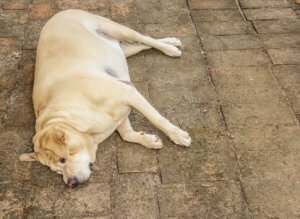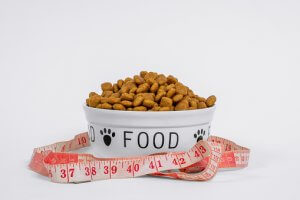Pet obesity can cause serious health issues such as cancer, arthritis, breathing difficulties, and skin disorders and can shorten your pet’s lifespan. While feeding your dogs too little food can leave them malnourished, feeding them too much can lead to obesity, which is why understanding the correct portion sizes is crucial when feeding your dog.
At the Animal Medical Center of Streetsboro, we’ve put together some tips for properly portioning your dog’s food:
Figure Out Your Dog’s Conditioning Score
 The body conditioning score or BCS is a way of evaluating your dog’s body fat. Once your veterinarian has visualized and palpated your pet, they will assign your pet a score from one to 9. One is extremely emaciated, and nine is extremely obese. Scoring is as follows:
The body conditioning score or BCS is a way of evaluating your dog’s body fat. Once your veterinarian has visualized and palpated your pet, they will assign your pet a score from one to 9. One is extremely emaciated, and nine is extremely obese. Scoring is as follows:Emaciated- 1
You can see the ribs, pelvic bone, lumbar vertebrae, and bony prominences, even from a distance. An emaciated dog will have no discernable body fat, and their muscle loss is obvious.
Very Thin- 2
You can easily see the ribs, pelvic bone, lumbar vertebrae, and bony prominences. Minimal muscle loss and no palpable fat are present.
Thin- 3
You can easily palpate their ribs, and the ribs may be easy to see. They have prominent lumbar vertebrae and pelvic bones. Their waist is also easily visible.
Ideal Weight- 4
They have palpable ribs with no excess fat. They have a waist that is evident, and their abdominal tuck is discernable.
Ideal Weight- 5
The dog has palpable ribs with no excess fat. When viewed from above, their waist is evident, and from the side, their abdomen is tucked up.
Overweight- 6
The ribs are palpable but under a slight fat covering with a discernable waist and abdominal tuck.
Heavy- 7
The ribs are under a heavy covering of fat and are difficult to palpate. You can see noticeable fat deposits on their lumbar area and at the base of the tail. Their waist is absent or hard to see. They have slight abdominal tuck.
Obese- 8
You cannot palpate the ribs, and they are underneath a heavy fat covering. You can see heavy fat deposits on the lumbar area and the base of the tail. The waist and abdominal tuck are not visible. You will also see obvious abdominal distention.
Severely Obese- 9
You will see major fat deposits across the dog’s body, tail, and spine. You may even see them on the neck and limbs, with an absent abdominal tuck and waist and abdominal distention.
Don’t Rely on the Label.
 While you may think the label on your dog’s food for recommended food amounts is accurate, they are actually just estimates, and they typically overestimate your dog’s food needs. The general estimates on your dog’s food bag do not consider your dog’s individual needs, which are based on breed, age, activity level, weight, and whether they are spayed or neutered.
While you may think the label on your dog’s food for recommended food amounts is accurate, they are actually just estimates, and they typically overestimate your dog’s food needs. The general estimates on your dog’s food bag do not consider your dog’s individual needs, which are based on breed, age, activity level, weight, and whether they are spayed or neutered.While you can use the label as a starting point, you don’t want to assume the label recommendations are completely accurate. Speak with your veterinarian for the correct serving size for your dog’s unique needs.
Determine Your Dog’s Daily Energy Requirements
With your dog’s specification, you can calculate their daily required energy. We recommend an online calculator to make this easier to do. The specification you need includes your pet’s:
- Weight
- Body Conditioning Score
- Species
- Spay or neuter status
With the caloric needs determined, you can then determine how much food they need daily. You can reference the dog food label to determine how many calories you feed your dog.
Be Sure to Measure Out Their Portions
While it may be easier to eyeball the portion, you need to make sure that you are using a measuring cup or kitchen scale for the most accurate portion size. Eyeballing the portion can lead to overfeeding or not feeding enough.
Keep An Eye on Your Dog’s Weight
You want to be sure that you are weighing your dog every two to four weeks and assessing their BCS. Use a notebook to track the results. This will give you a guide to notice weight changes and adjust their food intake as needed.
Don’t Forget About The Treats
When feeding your dog treats, we recommend keeping the treat at 10% of their caloric intake per day. You must ensure you include these calories in your dog’s overall energy requirements.
Call Your Veterinarian at Animal Medical Center of Streetsboro
If you have any questions or concerns regarding your dog’s weight or diet, be sure to talk to your veterinarian. We will use our knowledge and expertise to guide you in the right direction to meet your dog’s needs.

